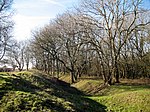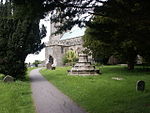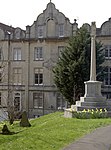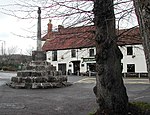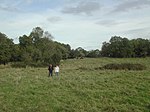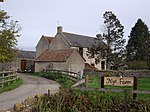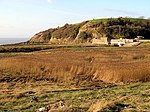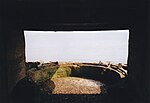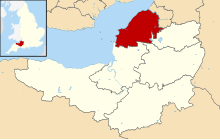
North Somerset is a unitary authority area in England. Its area covers part of the ceremonial county of Somerset but it is administered independently of the non-metropolitan county. Its administrative headquarters is in the town hall in Weston-super-Mare. North Somerset borders the local government areas of Bristol, Bath and North East Somerset, Mendip and Sedgemoor. North Somerset contains the parliamentary constituencies of Weston-super-Mare and North Somerset.
A scheduled monument is a nationally important archaeological site or monument which is given legal protection by being placed on a list (or "schedule") by the Secretary of State for Culture, Media and Sport; English Heritage takes the leading role in identifying such sites. The legislation governing this is the Ancient Monuments and Archaeological Areas Act 1979. The term "monument" can apply to the whole range of archaeological sites, and they are not always visible above ground. Such sites have to have been deliberately constructed by human activity. They range from prehistoric standing stones and burial sites, through Roman remains and medieval structures such as castles and monasteries, to later structures such as industrial sites and buildings constructed for the World Wars or the Cold War.
There are 68 scheduled monuments in North Somerset. The oldest site Aveline's Hole, a cave in which bones from the Mesolithic have been identified making it the earliest scientifically dated cemetery in Britain. There are also multiple Neolithic tumuli. There are also several Iron Age hillforts, such as the one at Worlebury Camp. Dolebury Warren, another Iron Age hillfort, was reused as a medieval rabbit warren. The Romano-British period is represented with sites including villas. Sites from the Middle Ages include motte-and-bailey castles, such as Locking Castle, and church crosses. There are also several deserted medieval settlements. Woodspring Priory is a former Augustinian priory founded in the early 13th century. More recent sites date from the Industrial Revolution and include the Elms colliery and glassworks in Nailsea. The most recent monuments are two Palmerstonian gun batteries, built in the 1860s, on the island of Steep Holm. The monuments are listed below using the titles given in the English Heritage data sheets.
Map all coordinates using OpenStreetMapDownload coordinates as:
Monuments
See also
- Scheduled Monuments in Somerset
- Grade I listed buildings in North Somerset
- Grade II* listed buildings in North Somerset
Notes
- The date given is the date used by Historic England as significant for the initial building or that of an important part in the structure's description.
- Sometimes known as OSGB36, the grid reference is based on the British national grid reference system used by the Ordnance Survey.
- The "List Entry Number" is a unique number assigned to each listed building and scheduled monument by Historic England.
References
- "Scheduled Monuments". English Heritage. Retrieved 9 September 2014.
- ^ "Earliest British cemetery dated". BBC. 23 September 2003. Retrieved 5 January 2010.
- William Page, ed. (1911). "Houses of Augustinian canons: The priory of Worspring". A History of the County of Somerset: Volume 2. Institute of Historical Research. Retrieved 15 October 2015.
- ^ Worrall, D. H.; Surtees, P. R. (1984). "Flat Holm – an account of its history and ecology". South Glamorgan County Council: 18–19.
{{cite journal}}: Cite journal requires|journal=(help) - Witcombe, Richard (2009). Who was Aveline anyway?: Mendip's Cave Names Explained (2nd ed.). Priddy: Wessex Cave Club. pp. 10–11. ISBN 978-0-9500433-6-4.
- Cunliffe, Barry (2012). Britain Begins. Oxford, UK: Oxford University Press. p. 125. ISBN 978-0-19-960933-8.
- "Archaeological Aerial Survey in the Northern Mendip Hills: A Highlight Report for the National Mapping Programme" (PDF). English Heritage. p. 32. Retrieved 29 January 2011.
- Historic England. "Banwell Camp (194460)". Research records (formerly PastScape). Retrieved 29 January 2011.
- "Mendip Hills". English Heritage. Retrieved 15 January 2011.
- "Mendip Hills". English Heritage. Retrieved 29 January 2011.
- Historic England. "Bell barrow 650 m south-west of Uphill Farm (1011130)". National Heritage List for England. Retrieved 6 December 2014.
- Historic England. "Bowl barrow 90 m south-west of Bicknell Farm (1008294)". National Heritage List for England. Retrieved 6 December 2014.
- Historic England. "Bowl barrow 170 m east of Poplar Farm (1008297)". National Heritage List for England. Retrieved 6 December 2014.
- Historic England. "Bowl barrow 230 m NNE of Quarry Farm: part of the Redhill round barrow cemetery (1011129)". National Heritage List for England. Retrieved 6 December 2014.
- Historic England. "Bowl barrow 300 m NNE of Quarry Farm: part of the Redhill round barrow cemetery (1011128)". National Heritage List for England. Retrieved 6 December 2014.
- Historic England. "Bowl barrow 420 m ENE of Quarry Farm: part of the Redhill round barrow cemetery (1011126)". National Heritage List for England. Retrieved 6 December 2014.
- Historic England. "Bowl barrow on Shiplate Slait (1009883)". National Heritage List for England. Retrieved 7 December 2014.
- Historic England. "Cadbury Camp (195367)". Research records (formerly PastScape). Retrieved 21 December 2013.
- Historic England. "Cadbury Camp, a small multivalate hillfort on Cadbury Hill (1008295)". National Heritage List for England. Retrieved 21 December 2013.
- "The Iron Age past of Cadbury Camp". National Trust. Retrieved 21 December 2013.
- "Long Ashton". Bath and Avon Family History Society. Retrieved 16 September 2014.
- Historic England. "Chapel, Immediately South of Lower Court Farmhouse (1129041)". National Heritage List for England. Retrieved 7 December 2014.
- Historic England. "Churchyard cross in St Andrew's churchyard (1016202)". National Heritage List for England. Retrieved 7 December 2014.
- Historic England. "Churchyard cross in St Bridget's churchyard, Chelvey (1015507)". National Heritage List for England. Retrieved 21 August 2014.
- Historic England. "Churchyard cross in St Andrew's churchyard (1015506)". National Heritage List for England. Retrieved 21 August 2014.
- Historic England. "Churchyard cross in All Saints churchyard (1015509)". National Heritage List for England. Retrieved 21 August 2014.
- Historic England. "Monument No. 192733". Research records (formerly PastScape). Retrieved 7 December 2014.
- Historic England. "Churchyard cross in St John The Evangelist's churchyard (1015515)". National Heritage List for England. Retrieved 7 December 2014.
- Historic England. "Churchyard cross in St Mary and St Peter's churchyard (1015875)". National Heritage List for England. Retrieved 7 December 2014.
- Historic England. "Churchyard cross in St Michael's churchyard (1015512)". National Heritage List for England. Retrieved 22 August 2014.
- Historic England. "Cross in St Lawrence's churchyard (1016198)". National Heritage List for England. Retrieved 7 December 2014.
- Historic England. "Congresbury village cross (1015505)". National Heritage List for England. Retrieved 7 December 2014.
- Historic England. "Deserted medieval farmstead 420 m south of Gout House Farm (1011133)". National Heritage List for England. Retrieved 7 December 2014.
- Historic England. "Deserted medieval farmstead and part of a Romano-British field system 400 m north of Fenswood Farm (1011979)". National Heritage List for England. Retrieved 7 December 2014.
- Historic England. "Deserted medieval settlement 300 m ESE of Wraxall House (1011259)". National Heritage List for England. Retrieved 7 December 2014.
- "Acquisitions Up to December 2011". National Trust. Archived from the original (PDF) on 14 July 2014. Retrieved 4 January 2015.
- "Mendip Hills. Things to see and do". National Trust. Retrieved 21 December 2013.
- Historic England. "Dolebury Camp: a large univallate hillfort and associated and later earthworks on Dolebury Warren (1008184)". National Heritage List for England. Retrieved 22 August 2014.
- Historic England. "Duck decoy, 250 m south of Black Rock Villas (1015949)". National Heritage List for England. Retrieved 7 December 2014.
- "Middle Engine Pit, Nailsea". Avon Industrial Buildings Trust. Retrieved 21 August 2014.
- "Heritage at Risk". Bristol Post. 11 July 2008. Archived from the original on 26 August 2014. Retrieved 21 August 2014.
- "Elms Colliery, Nailsea - North Somerset (UA)". Heritage at Risk. English Heritage. Retrieved 28 October 2015.
- Historic England. "Iron Age defended settlement 400 m south of Manor Farm (1018267)". National Heritage List for England. Retrieved 7 December 2014.
- Historic England. "Cadbury Hill Camp (195114)". Research records (formerly PastScape). Retrieved 22 March 2011.
- Rahtz, P (1992). Cadbury Congresbury 1968-73: a late Roman/Post-Roman Hilltop settlement in Somerset. BAR/BS 223
- Historic England. "Littleton gunpowder works at Powdermill Farm (1019452)". National Heritage List for England. Retrieved 7 December 2014.
- Historic England. "Long barrow on Redhill (1008289)". National Heritage List for England. Retrieved 7 December 2014.
- Historic England. "Long barrow 350 m south-west of Cornerpool Farm (1008291)". National Heritage List for England. Retrieved 7 December 2014.
- Historic England. "Moated site at Nye Farm (1011132)". National Heritage List for England. Retrieved 7 December 2014.
- Historic England. "Manorial settlement at Weston Manor (1007913)". National Heritage List for England. Retrieved 7 December 2014.
- Historic England. "Minor Romano-British villa 650 m north-east of Hewish Farm (1011262)". National Heritage List for England. Retrieved 7 December 2014.
- Historic England. "Locking Castle (1008301)". National Heritage List for England. Retrieved 23 July 2011.
- Historic England. "Locking Castle (192672)". Research records (formerly PastScape). Retrieved 22 July 2011.
- Dunning, Robert (1995). Somerset Castles. Tiverton: Somerset Books. pp. 39–40. ISBN 978-0-86183-278-1.
- Historic England. "Motte and bailey castle 650 m NNW of Sandpoint Farm (1008114)". National Heritage List for England. Retrieved 16 September 2014.
- Prior, Stuart (2006). The Norman Art of War: a Few Well-Positioned Castles. Stroud, UK: Tempus. p. 71. ISBN 0752436511.
- "YCCCART 2011 / Y9: North Somerset HER 2011/205, Castle Batch, Worle" (PDF). Yatton, Congresbury, Claverham and Cleeve Archaeological Research Team. Retrieved 9 January 2013.
- "Nailsea Glass". Nailsea Parish Family History and OPC Page. Retrieved 1 July 2010.
- Smith, Andrew F. (2004). "The Nailsea Glassworks, Nailsea, North Somerset A Study of the History, Archaeology, Technology and the Human Story". Archaeology Data Service (ADS). Retrieved 1 July 2010.
- Historic England. "Nailsea Glassworks (1021462)". National Heritage List for England. Retrieved 10 December 2014.
- Historic England. "Oval barrow on Felton Hill 100 m east of The Round House (1008300)". National Heritage List for England. Retrieved 10 December 2014.
- Historic England. "Parts of a minor Romano-British villa and later medieval barn 545 m south east of St Mary's Well (1007001)". National Heritage List for England. Retrieved 10 December 2014.
- Historic England. "Gatcombe Settlement (197955)". Research records (formerly PastScape). Retrieved 30 April 2011.
- Smisson; The Gatcombe Environs Research Team, RPM. "Extract from Gatcombe Roman Settlement Geophysical Surveys 2009/2010 Second Progress Report North of the Railway" (PDF). Yatton, Congresbury, Claverham and Cleeve Archaeological Research Team. Retrieved 5 January 2015.
- Historic England. "Romano-British villa, Banwell (1013434)". National Heritage List for England. Retrieved 21 August 2014.
- Historic England. "Shrunken medieval village of Christon and associated field system 200 m north of Manor Farm (1008186)". National Heritage List for England. Retrieved 10 December 2014.
- Historic England. "Burrington Camp (194391)". Research records (formerly PastScape). Retrieved 16 March 2011.
- "Mendip Hills An Archaeological Survey of the Area of Outstanding Natural Beauty" (PDF). Somerset County Council Archaeological Projects. Retrieved 16 January 2011.
- Historic England. "Slight univallate hillfort 150 m east of Cleeve Court (1011263)". National Heritage List for England. Retrieved 3 January 2015.
- Everden, Shirley (August 2009). "Enclosure At Chelvey Batch, Broadfield Down Earthwork Survey" (PDF). Retrieved 4 January 2015.
- Russet, Vince, ed. (2007). "Four Enclosures on Broadfield Down, North Somerset" (PDF). Yatton, Congresbury, Claverham, and Cleeve Archaeological Research Team. YCCCART: 4. Retrieved 4 January 2015.
- Historic England. "Wain's hillfort (192815)". Research records (formerly PastScape). Retrieved 6 March 2011.
- Historic England. "Conygar (195214)". Research records (formerly PastScape). Retrieved 6 March 2011.
- Historic England. "Slight univallate hillfort, two avenues, saucer barrow, regular aggregate field system and associated earthworks on Walton Common (1007917)". National Heritage List for England. Retrieved 3 January 2015.
- Historic England. "Slight univallate hillfort and associated settlement remains 300 m north-east of Cleeve Court (1011264)". National Heritage List for England. Retrieved 3 January 2015.
- "Stokeleigh Camp Hillfort". Hillfort in England in Somerset. Megalithic Portal. Retrieved 26 December 2010.
- "Stokeleigh Camp". Roman-Britain.org. Archived from the original on 3 July 2011. Retrieved 29 January 2011.
- Haldane, J.W. (1966). "Stokeleigh Camp, Somerset" (PDF). Proceedings of the University of Bristol Spelæological Society. 11 (1). Bristol: University of Bristol Spelæological Society: 31–38. Retrieved 30 January 2011.
- "Stokeleigh Camp". English Heritage. Retrieved 30 January 2011.
- "Where I Live: Bristol". BBC. October 2004. Retrieved 26 December 2010.
- Historic England. "Fairy Toot (198102)". Research records (formerly PastScape). Retrieved 2 April 2011.
- Dunn, Richard (2004). Nempnett Thrubwell:Barrows, Names and Manors. Nempnett Books. pp. 33–62. ISBN 0-9548614-0-X.
- Historic England. "Two bowl barrows 400 m north-east of Quarry Farm: part of the Redhill round barrow cemetery (1011127)". National Heritage List for England. Retrieved 3 January 2015.
- Historic England. "Two bowl barrows on Shiplate Slait (1008112)". National Heritage List for England. Retrieved 3 January 2015.
- Historic England. "Two confluent bowl barrows on Felton Hill (1008361)". National Heritage List for England. Retrieved 3 January 2015.
- Historic England. "Village cross (1129775)". National Heritage List for England. Retrieved 18 January 2010.
- Russett, Vince. "Gradiometry & Resistivity Surveys at Woodspring Priory" (PDF). Yatton, Congresbury, Claverham and Cleeve Archaeological Research Team. Retrieved 15 July 2014.
- Historic England. "Church of the Blessed Virgin Mary (1057100)". National Heritage List for England. Retrieved 19 October 2007.
- "Worlebury Camp". Roman-Britain.org. Archived from the original on 13 June 2010. Retrieved 5 October 2010.
- "Advice on Potential Landscape/Seascape and Visual Impacts of a Severn Barrage" (PDF). Land Use Consultants. Archived from the original (PDF) on 5 June 2014. Retrieved 4 January 2015.
- "Weston woods LNR". Natural England. Retrieved 4 January 2015.



